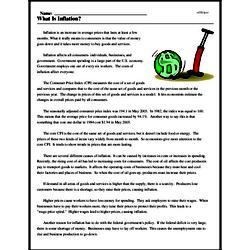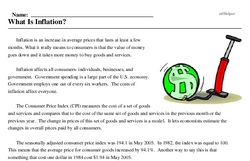What Is Inflation?
Inflation is an increase in average prices that lasts at least a few months. What it really means to consumers is that the value of money goes down and it takes more money to buy goods and services.
Inflation affects all consumers- individuals, businesses, and government. Government spending is a large part of the U.S. economy. Government employs one out of every six workers. The costs of inflation affect everyone.
The Consumer Price Index (CPI) measures the cost of a set of goods and services and compares that to the cost of the same set of goods and services in the previous month or the previous year. The change in prices of this set of goods and services is a model. It lets economists estimate the changes in overall prices paid by all consumers.
The seasonally adjusted consumer price index was 194.1 in May 2005. In 1982, the index was equal to 100. This means that the average price for consumer goods increased by 94.1%. Another way to say this is that something that cost one dollar in 1984 cost $1.94 in May 2005.
The core CPI is the cost of the same set of goods and services, but it doesn't include food or energy. The prices of these two kinds of items vary widely from month to month. So economists give more attention to the core CPI. It tends to show trends in prices that are more lasting.




